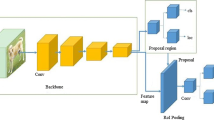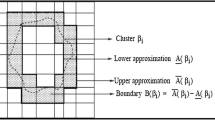Abstract
The article deals with the problems of motion detection, object recognition, and scene description using deep learning in the framework of granular computing and Z-numbers. Since deep learning is computationally intensive, whereas granular computing, on the other hand, leads to computation gain, a judicious integration of their merits is made so as to make the learning mechanism computationally efficient. Further, it is shown how the concept of z-numbers can be used to quantify the abstraction of semantic information in interpreting a scene, where subjectivity is of major concern, through recognition of its constituting objects. The system, thus developed, involves recognition of both static objects in the background and moving objects in foreground separately. Rough set theoretic granular computing is adopted where rough lower and upper approximations are used in defining object and background models. During deep learning, instead of scanning the entire image pixel by pixel in the convolution layer, we scan only the representative pixel of each granule. This results in a significant gain in computation time. Arbitrary-shaped and sized granules, as expected, perform better than regular-shaped rectangular granules or fixed-sized granules. The method of tracking is able to deal efficiently with various challenging cases, e.g., tracking partially overlapped objects and suddenly appeared objects. Overall, the granulated system shows a balanced trade-off between speed and accuracy as compared to pixel level learning in tracking and recognition. The concept of using Z-numbers, in providing a granulated linguistic description of a scene, is unique. This gives a more natural interpretation of object recognition in terms of certainty toward scene understanding.







Similar content being viewed by others
Explore related subjects
Discover the latest articles, news and stories from top researchers in related subjects.References
Yilmaz A, Javed O, Shah M (2006) Object tracking: a survey. Acm Comput Surv (CSUR) 38(4):13
Zadeh LA (1997) Toward a theory of fuzzy information granulation and its centrality in human reasoning and fuzzy logic. Fuzzy Sets Syst 90(2):111–127
Pal SK, Uma Shankar B, Mitra P (2005) Granular computing, rough entropy and object extraction. Pattern Recognit Lett 26(16):2509–2517
Pawlak Z (2012) Rough sets: theoretical aspects of reasoning about data, vol 9. Springer, Berlin
Debarati Chakraborty B, Shankar U, Pal SK (2013) Granulation, rough entropy and spatiotemporal moving object detection. Appl Soft Comput 13(9):4001–4009
Chakraborty DB, Pal SK (2016) Neighborhood granules and rough rule-base in tracking. Nat Comput 15(3):359–370
Pal SK, Chakraborty DB (2017) Granular flow graph, adaptive rule generation and tracking. IEEE Trans Cybern 47(12):4096–4107
Pal SK (2018) Data science and technology: challenges, opportunities and national relevance. In: 14th annual convocation speech: convocation address, National Institute of Technology, Calicut, India, Sept 29
LeCun Y, Bengio Y, Hinton G (2015) Deep learning. Nature 521(7553):436
Erhan D, Szegedy C, Toshev A, Anguelov D (2014) Scalable object detection using deep neural networks. In: Proceedings of the IEEE conference on computer vision and pattern recognition, pp 2147–2154
Ren S, He K, Girshick R, Sun J (2015) Faster r-cnn: towards real-time object detection with region proposal networks. In: Advances in neural information processing systems, pp 91–99
Redmon J, Divvala S, Girshick R, Farhadi A (2016) You only look once: Unified, real-time object detection. In: Proceedings of the IEEE conference on computer vision and pattern recognition, pp 779–788
Liu W, Anguelov D, Erhan D, Szegedy C, Reed S, Fu CY, Berg AC (2016) Ssd: single shot multibox detector. In: European conference on computer vision, Springer, pp 21–37
Krizhevsky A, Sutskever I, Hinton GE (2012) Imagenet classification with deep convolutional neural networks. In: Advances in neural information processing systems, pp 1097–1105
Kavukcuoglu K, Sermanet P, Boureau YL, Gregor K, Mathieu M, Cun YL (2010) Learning convolutional feature hierarchies for visual recognition. In: Advances in neural information processing systems, pp 1090–1098
Erhan Gundogdu A, Alatan A (2018) Good features to correlate for visual tracking. IEEE Trans Image Process 27(5):2526–2540
He Z, Fan Y, Zhuang J, Dong Y, Bai H (2017) Correlation filters with weighted convolution responses. In: Proceedings of the IEEE conference on computer vision and pattern recognition, pp 1992–2000
Oron S, Bar-Hillel A, Levi D, Avidan S (2015) Locally orderless tracking. Int J Comput Vis 111(2):213–228
Zhong W, Huchuan L, Yang MH (2014) Robust object tracking via sparse collaborative appearance model. IEEE Trans Image Process 23(5):2356–2368
Karpathy A, Toderici G, Shetty S, Leung T, Sukthankar R, Fei-Fei L (2014) Large-scale video classification with convolutional neural networks. In: Proceedings of the IEEE conference on computer vision and pattern recognition, pp 1725–1732
Ji S, Wei X, Yang M, Kai Y (2013) 3d convolutional neural networks for human action recognition. IEEE Trans Pattern Anal Mach Intell 35(1):221–231
Gan W, Lee MS, Wu CH, Kuo CCJ (2018) Online object tracking via motion-guided convolutional neural network (mgnet). J Vis Commun Image Represent 53:180–191
Held D, Thrun S, Savarese S (2016) Learning to track at 100 fps with deep regression networks. In: European conference on computer vision. Springer, pp 749–765
Zadeh Lotfi A (2011) A note on z-numbers. Inf Sci 181(14):2923–2932
Pal SK, Mitra S (1992) Multilayer perceptron, fuzzy sets, classifiaction. IEEE Trans Neural Netw 3(5):683–697
Pan SJ, Yang Q et al (2010) A survey on transfer learning. IEEE Trans Knowl Data Eng 22(10):1345–1359
Lin TY, Maire M, Belongie S, Hays J, Perona P, Ramanan D, Dollár P, Zitnick CL (2014) Microsoft coco: common objects in context. In: European conference on computer vision, Springer, pp 740–755
Zadeh LA (1996) \({\text{ Fuzzy }} {\text{ logic }}= {\text{ computing }} {\text{ with }} {\text{ words}}\). IEEE Trans Fuzzy Syst 4(2):103–111
Banerjee R, Pal S (2013) The z-number enigma: a study through an experiment. In: Soft computing: state of the art theory and novel applications, Springer, pp 71–88
Possegger H, Sternig S, Mauthner T, Roth PM, Bischof H (2013) Robust real-time tracking of multiple objects by volumetric mass densities. In: Proceedings of the IEEE conference on computer vision and pattern recognition (CVPR)
Visual tracker benchmark data. http://cvlab.hanyang.ac.kr/tracker_benchmark/datasets.html
Kristan M, Matas J, Leonardis A, Vojir T, Pflugfelder Roman, Fernandez Gustavo, Nebehay Georg, Porikli Fatih, Čehovin Luka (2016) A novel performance evaluation methodology for single-target trackers. IEEE Trans Pattern Anal Mach Intell 38(11):2137–2155
Jurrasic intro dataset. https://www.youtube.com/watch?v=lc0UehYemQA
Ferryman J, Shahrokni A (2009) Pets2009: dataset and challenge. In: 2009 twelfth IEEE international workshop on performance evaluation of tracking and surveillance (PETS-Winter), pp 1–6. IEEE
Head pose estimation in the wild using convolutional neural networks and adaptive gradient methods. https://github.com/mpatacchiola/deepgaze/blob/master/examples/ex_motion_detectors_comparison_video/cars.avi/
Pal SK, Ghosh A, Uma Shankar B (2000) Segmentation of remotely sensed images with fuzzy thresholding, and quantitative evaluation. Int J Remote Sens 21(11):2269–2300
Taormina R, Chau KW, Sivakumar B (2015) Neural network river forecasting through baseflow separation and binary-coded swarm optimization. J Hydrol 529:1788–1797
Wu CL, Chau KW (2011) Rainfall-runoff modeling using artificial neural network coupled with singular spectrum analysis. J Hydrol 399(3–4):394–409
Acknowledgements
Valuable discussion with Ms. Romi Banerjee is gratefully acknowledged. S.K. Pal acknowledges the INSA Distinguished Professorship. D. Bhunia Chakraborty acknowledges CSIR for providing her Research Associateship.
Author information
Authors and Affiliations
Corresponding author
Additional information
Publisher's Note
Springer Nature remains neutral with regard to jurisdictional claims in published maps and institutional affiliations.
Rights and permissions
About this article
Cite this article
Pal, S.K., Bhoumik, D. & Bhunia Chakraborty, D. Granulated deep learning and Z-numbers in motion detection and object recognition. Neural Comput & Applic 32, 16533–16548 (2020). https://doi.org/10.1007/s00521-019-04200-1
Received:
Accepted:
Published:
Issue Date:
DOI: https://doi.org/10.1007/s00521-019-04200-1




